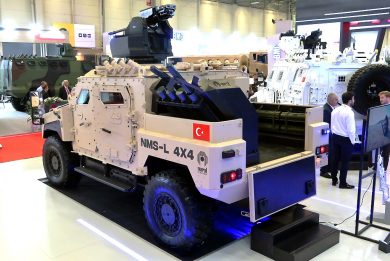
SAHA Expo 2024 – Aselsan Korkut 25; a C-UAS hard-kill solution for light armoured vehicles
Looking at the light armoured vehicles market, Aselsan developed a light solution that is now part of the Korkut air defence systems family, the Korkut 25 being installable on a wide variety of light platforms

Standing in the outside area at SAHA Expo, the defence exhibition that is taking place in Istanbul 22-26 of October, not far away from its big brother, the Korkut 35, the new system developed by Aselsan is clearly of a wholly different category, however it ensures good hard kill capability against drones, albeit at a much shorter range, slightly over 1,000 meters according to the company.
While developing the land-based 25 mm weapon system, which included the 25×137 mm Atom airburst round, Aselsan engineers had the idea to exploit the new ammunition in the Counter-UAS role, to kill unmanned air systems at range. “We considered weight, in order to be capable to install the Korkut 25 on a wide variety of vehicles, as well as cost,” an Aselsan representative explained to EDR On-Line.

The system lethality is given by a chain that starts with the target detection and ends with its neutralisation, the key element for the latter being the ammunition. The Atom 25 mm round is a pre-fragmented projectile filled with high explosive. From the rear to the front we find the power source, the base fuse with its electronics, the booster and finally the pre-fragmented body. The latter was the subject of deep studies in terms of materiel and pre-fragmentation in order to generate the appropriate cloud of fragments to cause maximum damage to the target, usually a Class 1 drone. While the 35 mm round used on the Korkut is filled with tungsten cylinders, the room available in the 25 mm did not allowed such a solution hence the decision to go for a pre-frag HE ammunition.

The 25 mm gun muzzle is fitted with a muzzle brake that includes coils tat allow measuring the velocity of the single round, data being fed into the programming system which generates a current into the last magnetic coil, which programmes the smart fuse by induction before the round leaves the gun. The programming is done on the base of data provided by the tracking system, which determinates the point where the round must be ignited to generate the cloud of fragments, usually a 10-round burst being fired to ensure maximum kill probability. The Korkut 25 turret hosts 200 rounds therefore a single system can carry out 20 engagements before needing to be reloaded.

At SAHA Expo the Korkut 25 was installed on a Ejder Yalçin 4×4 vehicle by Nurol Makina, a vehicle with a GVW of 12-14 tonnes. According to Aselsan, the Korkut turret has a mass of 1-1.2 tonnes with gun and without ammunition. It is fitted with an optronic head located on the right side of the gun; this hosts a day TV channel, a night thermal channel, and a laser rangefinder. The main detection asset is however not installed on the turret; at the back of the vehicle a telescopic mast carries on top an array of four AESA antennas, the radar thus covering 360°. The priority target is also taken in charge by the optronic system, the two sensors allowing its identification. EDR On-Line understood that some artificial intelligence-based algorithms are currently being developed to provide Aselsan C-UAS systems with new capacities, increasing the decision assistance to the operator, who is always the final responsible to push the engage button.

According to Aselsan the Korkut 25 has a significant cost-effectiveness against such type of threat, while of course retaining its capabilities against ground targets. The development was straightforward as most of the components were already available in-house, such as the radar, optronics, ammunition etc, “therefore we had mostly to modify some algorithms, as around 80% of the components were already available,” an Aselsan source told us.
Photos by P. Valpolini


